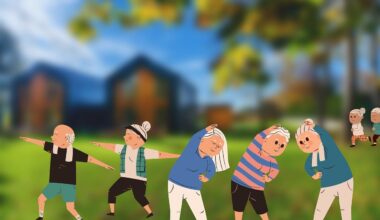Functional Training for Muscle Building in Older Adults
As individuals age, the importance of maintaining physical health becomes increasingly vital. Functional training offers a way to enhance muscle strength and balance, which is crucial for overall stability and mobility. It focuses on movements that mimic daily activities, promoting strength in multiple muscle groups simultaneously. This method of training helps build functional strength, enhancing the quality of life in older adults. It prevents injuries that often come with age by strengthening muscles and improving coordination. Not only does functional training boost muscle mass, but it also helps in maintaining bone density, reducing the risk of osteoporosis. Properly executed exercises can encourage cardiovascular fitness, which is another vital aspect of aging gracefully. Popular functional exercises, such as squats, lunges, and push-ups, can be modified for different fitness levels. It is essential for older adults to start with lighter weights and focus on form to maximize benefits. By incorporating functional training into their routines, older adults can experience improved mobility, balance, and functional strength, which significantly contributes to their independence and confidence in performing everyday tasks.
Functional training targets core stability, which is a fundamental aspect of muscle building for older adults. A strong core is instrumental in various exercises and daily movements. It plays a critical role in maintaining balance and preventing falls, which are prevalent concerns in aging populations. Strengthening core muscles also supports proper posture, which can alleviate back pain commonly experienced by seniors. Exercises such as planks, bridges, and rotational movements are excellent for engaging core muscles and can be adjusted for intensity based on individual needs. Improving core strength through functional training can lead to enhanced athletic performance, as these muscles are central to movements like bending or reaching. Additionally, this training fosters better stability and reduces the likelihood of injuries. Older adults may benefit significantly from engaging in core-focused functional exercises since these not only enhance muscle strength but also promote flexibility and coordination. Importantly, this holistic approach ensures that workouts are tailored to be safe yet effective for older individuals. With consistent training, they can witness notable improvements in their strength, balance, and overall quality of life as they age, making functional training an indispensable component of fitness.
The Role of Resistance Training
Resistance training is a fundamental aspect of functional training, especially for muscle building among older adults. This form of exercise helps in improving muscular strength and endurance by working against resistance such as weights or resistance bands. When older individuals engage in resistance training, they stimulate muscle hypertrophy, which is crucial to counteract age-related muscle loss, known as sarcopenia. By integrating resistance exercises into a weekly routine, elders can effectively enhance their muscle mass, improving their physical capabilities. For those new to strength training, starting with bodyweight exercises is a great way to build a foundation. As proficiency increases, they can gradually introduce weights or bands. Exercises like seated row, chest press, and leg press are powerful tools for enhancing muscle strength. Furthermore, when resistance training is combined with functional training, it equips older adults with the necessary strength to perform daily tasks, such as lifting groceries or climbing stairs. Safety is paramount, so older individuals should always consult a fitness professional or a physician before starting any new training program to ensure it meets their health criteria.
Nutrition plays an indispensable role in muscle building, particularly for older adults engaging in functional training. Consuming adequate protein is essential for muscle repair and growth. Older adults need to be conscious of their dietary choices to support their training goals effectively. Prioritizing lean sources of protein such as chicken, fish, beans, and dairy can nurture muscle tissue, especially after workouts. Additionally, a balanced diet incorporates carbohydrates and healthy fats, ensuring sufficient energy levels for training sessions. Micronutrients, such as vitamins and minerals, also contribute to overall health and should be included in daily meals. Staying hydrated is essential for optimal performance, particularly during exercise. Inadequate hydration can lead to fatigue and hinder training effectiveness. Older adults must be mindful of their water intake throughout the day, especially before, during, and after workouts. Maintaining a food diary or consulting with a nutritionist may assist in tracking dietary intake and making modifications for optimal muscle building. By linking proper nutrition to their functional training routines, older adults can maximize their results, ensuring longevity in their physical fitness and overall health.
Common Functional Exercises for Muscle Building
There are various functional exercises that older adults can incorporate into their routines to build muscle effectively. These exercises not only enhance muscle strength but also promote overall fitness and functional mobility. Some of the most effective exercises are squats, which target the lower body muscles, including quadriceps and hamstrings. Lunges are another excellent option, fostering balance and stability, while also engaging core muscles. Push-ups can be modified for all fitness levels, providing upper body strength benefits. Furthermore, incorporating movements like kettlebell swings and medicine ball exercises can challenge the body while promoting coordination. Resistance bands are a fantastic tool for older adults, allowing them to perform a range of exercises without the need for heavy weights. Additionally, functional training should always prioritize proper technique to prevent injuries. Listening to the body’s signals is crucial; if discomfort arises, modifications should be made. Regularly alternating between various exercises can keep workouts engaging and challenging, ultimately leading to better outcomes in muscle building and overall fitness improvement. Record your progress to stay motivated and focused on your muscle building journey.
Adopting a consistent workout routine is paramount for older adults focusing on muscle building through functional training. A well-structured plan often entails training multiple times a week, allowing adequate recovery time between sessions. It is beneficial to alternate between strength, balance, and flexibility exercises to cultivate a well-rounded approach, ensuring all aspects of physical fitness are catered for. Incorporating low-impact cardio exercises like walking or cycling can improve endurance and cardiovascular health, complementing muscle-building workouts. Setting realistic goals can foster motivation, making progress palpable for older adults as they engage in their routines. Furthermore, seeking social support through group classes or training with a friend can enhance accountability and enjoyment during workouts. In addition, older adults should consider working with a certified personal trainer who specializes in geriatric fitness to gain personalized guidance tailored to their individual needs and capabilities. Recovery methods such as stretching and foam rolling should not be neglected, as they play a critical role in preventing injury and promoting flexibility. By creating and adhering to a comprehensive workout plan, older adults can lead healthier, more active lives while experiencing the numerous benefits of muscle-building functional training.
The Importance of Rest and Recovery
Rest and recovery are crucial components of any workout regimen, especially for older adults engaging in functional training for muscle building. Overtraining can lead to injuries, fatigue, and diminished progress, making it essential to allow the body time to repair and build muscle. Adequate sleep is vital for recovery, as this is when the body repairs tissues and regenerates muscle cells. Aim for seven to nine hours of quality sleep each night to maximize recovery processes. Incorporating rest days into training schedules is equally important, providing muscles a chance to recover from the stress of workouts. During these rest days, light activities such as walking or gentle stretching can promote blood flow to muscles without stressing them further. Nutrition, as previously mentioned, also plays a role in recovery by supplying the necessary nutrients for muscle repair. Listening to bodily cues is essential; if fatigue persists, consider extending rest periods or modifying training intensity. Recovery is not an indulgence, but rather an integral component supporting strength gains and overall well-being, enabling older adults to engage in functional training effectively without prolonging injuries and setbacks in their fitness journeys.
Consistency is the key to success in functional training for muscle building among older adults. Establishing a routine can help in developing lasting habits that contribute significantly to improved strength and fitness levels. Utilizing calendars or fitness apps can assist in tracking progress and ensuring adherence to suggested training sessions. When they celebrate small victories, older adults can maintain motivation and stay committed to their workout plans. Establishing a supportive community or joining a fitness group tailored to older adults can significantly enhance the experience, allowing individuals to share challenges and celebrate successes together. Joining group classes led by a knowledgeable instructor can help learn new skills and ensure exercises are performed safely and effectively. A supportive atmosphere fosters a sense of belonging and accountability, further encouraging continued participation. Additionally, setting SMART goals—specific, measurable, achievable, relevant, and time-bound—can provide clarity and focus in the pursuit of muscle building through functional training. By understanding that progress takes time, older adults can cultivate patience while still committing to their fitness journey, ultimately gaining the benefits of functional training for muscle building and overall health improvement.


